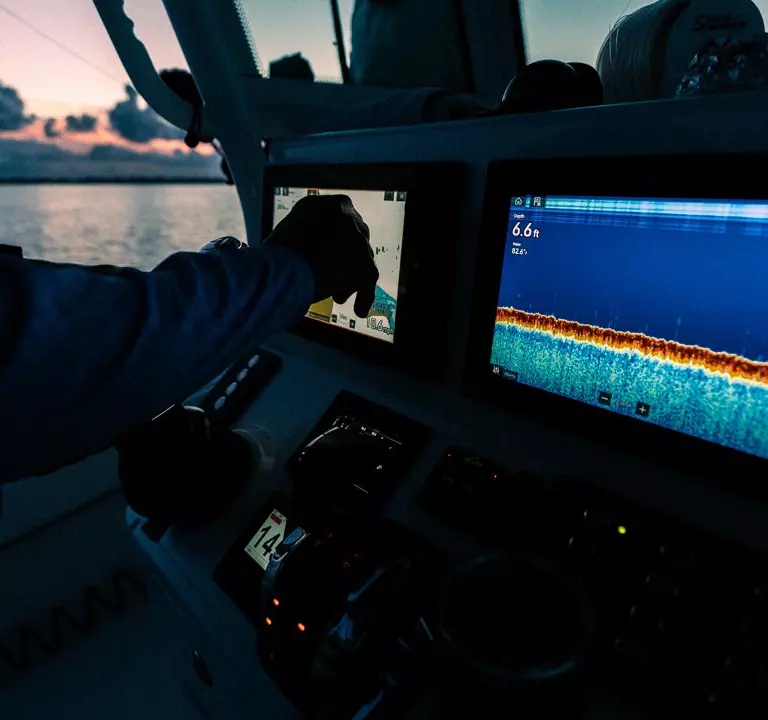
23 August 2022
The transducer is the heart of a sonar system. The device converts electrical pulses into acoustic energy or sound waves and transmits these waves into the water. When the transducer receives the reflections (echoes), the sonar module converts the sound waves back to electrical pulses to interpret what is below the surface of the water.
Sonar transducers can be used to detect fish, bottom structures and the sea/riverbed topography. They can record the depth and temperature of the water, the speed of the boat and can generally aid in navigation by rendering images of what's below the boat.
Raymarine offers a wide range of depth, speed and temperature transducers that work with instruments, multifunction displays and sonar modules.
Transducers are available in transom mount, in-hull, or through hull, and tilted element configurations. They come in plastic composite, bronze, or stainless steel to fit practically any boat on the water.
With a range of mounting styles, it's important to learn which type of transducer is correct for your boat and boating needs.
As the name implies, transom mount transducers are installed on the boat's transom, hanging into the water and typically protruding just below the level of the bottom of the hull. Transom mounts are composed of plastic and tend to be less expensive than other transducers, though high-performance transom mount solutions are available for some fishing applications.
Transom mount transducers are recommended for planing hulls of less than 27 feet (8 meters), such as personal watercraft and powerboats with outboard, inboard-outboard and jet drives. They are not recommended for large or twin-screw inboard boats because aerated water from the propeller reduces performance. They are also not recommended for critical operation at very high speeds. While well-adjusted transom mount transducers have been proven to work at speeds in excess of 30 knots, a through-hull or in-hull may be a better option for sustained high-speed running.
Transom mounts adjust to transom angles from 3° – 16°. For angles greater than 16°, a tapered plastic, wood or metal shim will be needed. However, the transducer should be adjusted so it is angled slightly forward when the boat is in the water.
In-hull (a.k.a. shoot-through) transducers are epoxied directly to the inside of the hull. These are only used in solid fiberglass hulls without any kind of core material. In-hulls will not work with wooden, aluminum, or steel hulls, or in foam sandwich/hulls that have air pockets. Any wood, metal, or foam reinforcement must be removed from the inside of the hull.
With an in-hull transducer, the signal is transmitted and received through the hull of the boat. As a result, there is loss of sonar performance compared to a “wet” transducer solution. In other words, you won't be able to read as deep or detect fish as well with an in-hull transducer as with one that's transom mounted or thru-hull mounted.
Fiberglass hulls are often reinforced in places for added strength. These cored areas contain balsa wood or structural foam, which are poor sound conductors. The transducer will need to be located where the fiberglass is solid and there are no air bubbles trapped in the fiberglass resin. You'll also want to make sure that there is no coring, flotation material, or dead air space sandwiched between the inside skin and the outer skin of the hull.
Through-hull transducers are mounted through a hole drilled in the bottom of the boat and protrude directly into the water. This type of transducer generally provides the best all-around performance.
Through-hulls are recommended for displacement hulls and boats with straight-shaft inboard engines. You'll also need a fairing block that allows the transducer to be mounted properly. Through-hull transducers must be installed with a fairing to ensure proper alignment and a secure fit.
Through-hull transducers must be positioned in front of the propeller, rudder, keel or anything else that may create turbulence. They must be mounted in a position that is always underwater and angled straight down.
Tilted Element transducers are mounted through a hole drilled in the bottom of the boat and protrude directly into the water. Tilted Element transducers offer performance similar to through-hulls.
Tilted Element transducers are mounted flush against the hull. Unlike traditional Through-Hull transducers, Tilted Elements do not need a fairing block. The element inside the transducer acts as a levelling agent, working with the deadrise (angle) of your hull to ensure the transducer's beam is directed straight down.
These transducers will generally come in two configurations based on your hull type, a 12º and 20º version. Select a 12º tilt when the deadrise of your hull falls in the 8º to 15º range. Select the 20º tilt if your hull's deadrise is in the 16º to 24º range.
When installing a Tilted Element transducer make sure to position it in front of the propeller, rudder, keel, or anything else that may create turbulence. They also must be mounted in a position that is always underwater and angled within the appropriate deadrise range. Most in-hull transducers will have markings on them that must point towards the boat’s keel/centerline when installed. This ensures that the tilted offset angle is properly aligned.
For more information on which transducer is right for you, check out our article on Choosing a Transducer.